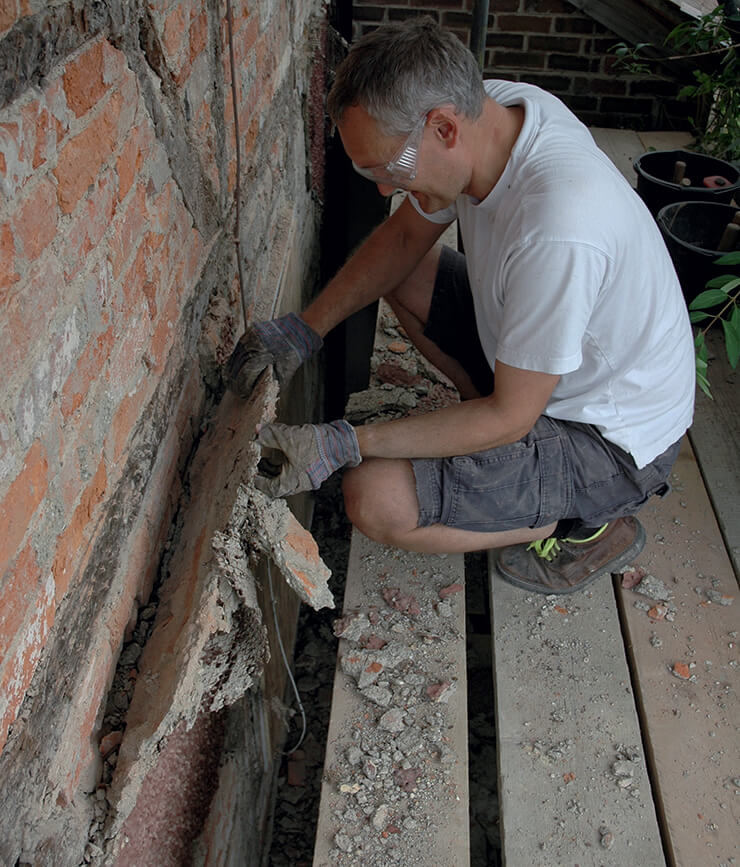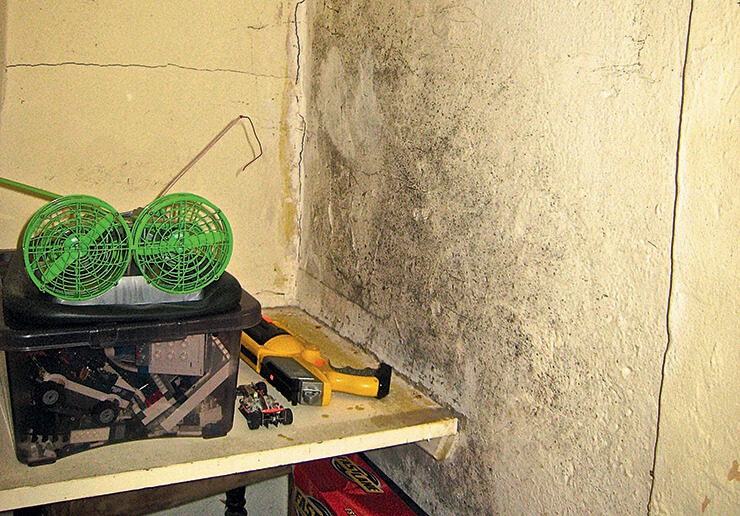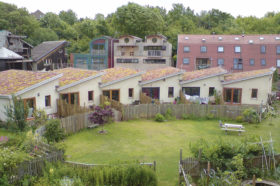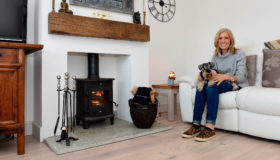
Learn from the experts with our online training course!
Use the code BUILD for 20% off
Learn from the experts with our online training course!
Use the code BUILD for 20% offCondensation and other damp problems can have serious implications for any building, whether old or new, as they can damage the fabric and finishes and may even lead to health issues. But it’s easy to become more concerned than you really need to be and therefore end up taking the wrong approach to dealing with damp.
It’s common for homeowners to be unsure of what consequences it could have for their property, for example, and to get the significance of the issues in the wrong order. This has a bearing on treatment priorities and can lead to people commissioning ineffective, inappropriate or even damaging remedial work.
In this guide, I’ll be clearing up the main considerations you need to account for and helping you to identify the best ways to tackle condensation and other damp problems in a heritage home.
Understanding what kind of damp is affecting your property can help you to identify potential causes – but as we’ll see later in this article, it’s easy to take the wrong course if you focus on the symptoms rather than the root of the issue. There are three main categories, which are generally characterised by their source:
Rising damp is the result of ground water creeping up the walls (or sometimes floors) by capillary action. It is most commonly seen at the base of walls, often leaving a tide mark at the limit of its extent. This is caused by the soluble salts that tend to be contained within ground water, which will become visible as white salt efflorescence as the wall dries.
Rising damp is much less common than is generally thought. It is frequently misdiagnosed and ends up being treated with expensive, ineffective and potentially damaging methods.
Penetrating damp is where water passes through the external fabric of the building and saturates the depth of the wall. It tends to become contaminated as it moves through the fabric, leaving brown staining on the internal surface. Issues seen at high level are most likely to be penetrating damp, but it can occur at any height. In fact, water damage at the base of a wall is more likely to be a result of penetrating rather than rising damp.
Condensation is caused when the water vapour contained in warm internal air meets a cold surface, encouraging it to revert to its liquid state. It can occur on the internal face of walls and other parts of the building fabric, particularly in poorly ventilated areas. It can also form within the wall itself. This is known as interstitial condensation and often occurs behind modern interventions, such as drylining or insulation.
Condensation is often provoked by other forms of damp that might cause the external walls to be cold. It is characterised by black mould growth.

Harmful cement render is removed from a 17th century timber framed cottage
The most serious consequence of damp is harm to the fabric of the building. Timber, for instance, can suffer significant decay if rot fungi and wood-boring beetles take hold. This can lead to extensive damage and, in the worst cases, even cause structural failure. Masonry is much less at risk but will still deteriorate in extreme damp conditions.
Thermal performance is the next big issue. A damp building loses up to 30% more heat through its walls than a dry one, which has knock-on consequences for comfort levels and heating bills. It can also provoke problems with condensation-driven mould growth.
Water vapour within the building will tend to condense on cold surfaces; and this in turn promotes the growth of black mould. The spores released by the mould can be very harmful to human health.
The most visibly obvious effect of damp is staining and degradation of internal decorative finishes. This is what most often causes concern and promotes strong remedial action. While it’s annoying, it’s actually far less serious than the issues described above because it doesn’t have consequences for the health and comfort of the building or its occupants. Internal symptoms are therefore crucial indicators that there may be damp – but it’s important not to assume these are the main problems to overcome.
To be able to deal with damp in an old house it is essential to understand how the building works, particularly in terms of managing moisture. The process is different to what happens in modern buildings designed with cavity walls, vapour barriers and impermeable materials to keep water out of the structural envelope.
Before about 1919, houses were built from permeable materials, with solid walls and no damp proof course or membranes. These properties manage moisture by absorption and evaporation. So water from rain, the ground or vapour-laden air generated by occupants all soaks into the structural fabric and then readily evaporates through the permeable finishes. This process is referred to as breathability and results in a balanced equilibrium that prevents the building from becoming damp.
As long as the routes for absorption and evaporation are left open then the system works very well. But if those paths are blocked by the introduction of modern materials – such as vapour barriers, damp proof membranes, impervious plasters, renders or paints – then serious damp problems can result.

Here, condensation-driven mould growth has taken hold on a cold, damp wall in an unventilated cupboard
One of the biggest mistakes when dealing with this issue in period properties is to focus on the kind of damp that’s present. This is merely a symptom of an underlying cause. Much expensive, unnecessary and damaging work is carried out on old buildings trying to treat symptoms rather than the root of the problem.
The only effective way to deal with damp is to identify where the water is coming from and the mechanisms involved. Often this can be a complex issue, and it may even be the result of a combination of factors – hence why remedies sold as catch-all solutions may not be up to the task. The most common sources and causes of damp in old buildings are:
Gutters and downpipes: Inadequate, poorly maintained or leaking gutters can concentrate large amounts of rainwater in one part of a wall. Even an apparently insignificant drip from a leaking joint will yield a surprisingly large volume of water, risking damp in the adjacent wall.
Similarly, extreme rainfall can overwhelm gutters, pouring large amounts of water into the wall below. Climate change is increasing the frequency of such events, so gutters that used to be adequate are often not any more. In addition, pinholes in downpipes can spray a powerful jet into the wall behind.
Another consideration is that it’s surprisingly common for downpipes to empty at the base of walls, with obvious consequences, rather than into a surface water drain that would expel rain well away from the house.
Cement renders: Using impervious materials or finishes on the outside of a wall will disrupt its breathable performance as they will prevent evaporation. To make matters worse, a cement render is rigid and inflexible; while a period home’s underlying building fabric, because of its softer construction materials, is subject to a higher degree of natural movement.
The inevitable result is that the render will crack; and these fissures will let in driving rain that becomes trapped, making the wall progressively damper.
Modern floors: Replacing a breathable solid floor, such as brick or quarry tiles, with an impermeable option (eg solid concrete with a damp-proof membrane) will prevent rising ground water from evaporating through the structure as it should. When the water hits the barrier, it is forced sideways into the base of the wall, which then becomes damp.
Defective pointing: If there are gaps in the finishing mortar of the external face of a wall, driving rain will penetrate into the structural fabric but be unable to escape, making it damp.
Raised ground: The external ground level should always be lower than the internal floor. If not, water contained in the soil will penetrate the wall above the internal floor level, causing it to become damp. If there is a suspended timber floor this can provoke severe decay, particularly to the joist ends.
The situation is made very much worse if there is hard landscaping right up to the wall, especially if it does not have a good fall (incline) down and away from the house.
Inadequate ventilation: Modern living creates a large amount of water vapour from sources such as cooking, washing, bathing and occupants breathing. If there is not sufficient ventilation to remove this airborne moisture, serious condensation problems can result, especially if walls are already cold, damp or both. Effective extract ventilation in kitchens and bathrooms is crucial for preventing this.


Comments are closed.